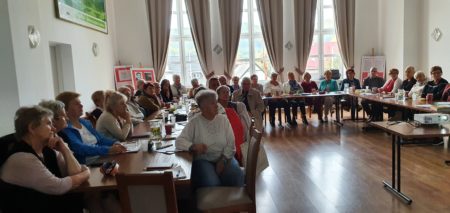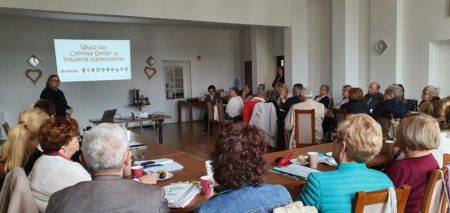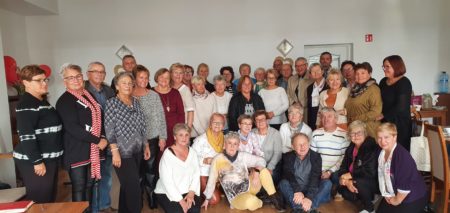Konferencja odbyła się w Centrum Aktywności Społecznej w Podgórzynie jako spotkanie wymiany doświadczeń oraz podsumowanie projektu.
Program spotkania:
– O projekcie oraz jego realizacji – Irena Krukowska-Szopa Fundacja Ekologiczna „Zielona Akcja”, –
– Problemy Rad Seniorów w kontekście spotkań regionalnych; rekomendacje dla władz lokalnych i regionalnych – Zdzisław Ratajski Przewodniczący Rady Seniorów Powiatu Karkonoskiego,
– Kompetencje cyfrowe seniorów – jak zachęcać seniorów do korzystania z cyfrowych udogodnień – Dorota Goetz Prezeska Lokalnej Grupy Działania Partnerstwo Ducha Gór,
– Wyzwania lokalnej polityki senioralnej – uwarunkowania społeczne i zdrowotne – przedstawiciel FPDO
– Prezentacje inicjatyw „Na przekór pandemii 2021” oraz „Seniorzy rozwijają skrzydła 2022” – przez przedstawicieli 5 Rad Seniorów Janowice Wielkie, Rad Seniorów Lubawka, Rad Seniorów Lubin, Rad Seniorów Mieroszów, Rad Seniorów Podgórzyn,
– Film promujący inicjatywy seniorów,
– Moderacja prac w grupach – wyzwania i plany działań Rad Seniorów na 2023 rok,
– Podsumowanie spotkania,
– Poczęstunek uczestników.
Na konferencję dojechali przedstawiciele wszystkich 5 Rad seniorów z terenu gmin Lubawka, Lubin, Mieroszów, Janowice Wielkie, Podgórzyn, byli również przedstawiciele Urzędu Gmny Podgórzyn oraz Lubin. Wzięły udział 44 osoby.
Seniorzy w trakcie prac w grupach oraz dyskusji wskazywali na następujące problemy i wyzwania:
– rosnąca grupa osób 60+ w wielu gminach oddalonych od dużych miast,
– nie zawsze strategie gminne uwzględniają problemy i rozwiązania dla seniorów, a nawet gdy są wpisane to niewiele się z tego realizuje,
– konieczność aktywizowania społecznego osob 60 + wychodzenie z informacjami, tworzenie miejsc spotkań, wykorzystanie pomieszczeń które mogą służyć seniorom, powoływanie organizacji senioralnych, przeznaczenie środków w budżetach gmin na działania senioralne oraz w funduszach sołeckich
– zapewnienie środków na delegacje członków Rad seniorów oraz wsparcie działań rad na forum gminnym ( nie tylko dawanie pomieszczenia i kawy na spotkania Rad seniorów)
– pomoc w pisaniu projektów
– zapewnienie wstępu przedstawicieli Rad seniorów ma posiedzenia Rad Gmin
– pomoc w pisaniu projektów na działania senioralne
– pomoc prawna dla seniorów
– wspieranie cyfrowe seniorów oraz Rady seniorów np. poprzez pomoc informatyków gminnych
– wymiana dobrych praktyk pomiędzy Radami seniorów oraz organizacjami senioralnymi
– pomoc w powoływaniu Rad seniorów w gminach mniejszych
– zapewnienie transportu przynajmniej dwa razy dziennie dla seniorów którzy muszą dojechać do Ośrodka zdrowia lub Urzędu Gminy
– podnoszenie kompetencji cyfrowych oraz zapewnienie odpowiedniego sprzętu
– przyjazna przestrzeń, także bez barier dla seniorów
– zapewnienie odpowiednich usług zdrowotnych, także specjalistycznych
– zapewnienie badań profilaktycznych.
Rady seniorów mogą:
– inspirować do działania, proponować rozwiązania Radom Gmin
– współpracować z organizacjami pozarządowymi z terenu gminy,
– przeciwdziałanie samotności – współorganizacja wydarzeń, warsztatów,
– dzielenie się wiedzą i doświadczeniem z młodszymi pokoleniami,
– tworzyć warunki do woluntariatu dla seniorów znajdujących się w trudnej sytuacji życiowej, zdrowotnej,
– współorganizować i uczestniczyć w imprezach i cyklicznych zajęciach rekreacyjno-sportowych i tanecznych,
– współpracować blisko z UTW oraz GOPS.
Ogólny wniosek – konieczne częstsze spotkania aktywnych seniorów aby się wzmacniać nawzajem dobrą energią i przekonaniem że warto działać.
- prezentacja Rady Seniorów Gminy Janowice Wielkie (pobierz pdf)
- prezentacja Rady Seniorów Gminy Lubawka (pobierz pdf)
- prezentacja Rady Seniorów Gminy Lubin (pobierz pdf)
- prezentacja Rady Seniorów Gminy Mieroszów (pobierz pdf)
- prezentacja Rady Seniorów Gminy Podgórzyn (pobierz pdf)



